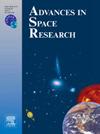A general three-component polarimetric SAR interferometry target decomposition
IF 2.8
3区 地球科学
Q2 ASTRONOMY & ASTROPHYSICS
引用次数: 0
Abstract
In this study, a general three-component polarimetric SAR interferometry (PolInSAR) target decomposition framework is proposed by modifying the existing generalized surface, double-bounce, and volume models. The resulting general models are then compared to the original Freeman-Durden modeling strategy. Three types of generalized volume scattering models (generalized volume scattering model (GVSM), simplified Neumann volume scattering model (SNVSM) and simplified adaptive volume scattering model (SAVSM)) were employed. Simulated L-band PolInSAR data over deciduous and pine forest stands generated by PolSARpro and DLR P-band airborne PolInSAR data over a tropical forest area from the AfriSAR 2016 campaign were used for performance analysis. A qualitative comparison of the decomposition results shows that the three generalized volume scattering models generally deviate from the Freeman-Durden model, showing that the GVSM and SNVSM models have very similar results. In the case of airborne data over tropical forests, a tomographic synthetic aperture radar (TomoSAR) profile was also computed and used as a benchmark for comparison with the phase-center profiles of all four volume-scattering components. Not only do the GVSM and SNVSM models exhibit similar results between them (as with simulated data), but also a better match with the HV TomoSAR profile.
一般三分量偏振合成孔径雷达干涉测量目标分解
本研究通过修改现有的广义表面模型、双弹跳模型和体积模型,提出了一种通用的三分量偏振合成孔径雷达干涉测量(PolInSAR)目标分解框架。然后将由此产生的通用模型与最初的 Freeman-Durden 建模策略进行比较。采用了三种广义体散射模型(广义体散射模型(GVSM)、简化诺伊曼体散射模型(SNVSM)和简化自适应体散射模型(SAVSM))。性能分析使用了 PolSARpro 生成的落叶林和松林林分 L 波段 PolInSAR 仿真数据,以及 2016 年非洲合成孔径雷达(AfriSAR)活动中热带林区的 DLR P 波段机载 PolInSAR 数据。分解结果的定性比较显示,三种广义体散射模型普遍偏离弗里曼-杜登模型,表明 GVSM 和 SNVSM 模型的结果非常相似。对于热带森林上空的机载数据,还计算了断层合成孔径雷达(TomoSAR)剖面图,并将其作为基准与所有四个体散射分量的相位中心剖面图进行比较。GVSM 模型和 SNVSM 模型不仅显示出相似的结果(与模拟数据相似),而且与 HV TomoSAR 剖面更为匹配。
本文章由计算机程序翻译,如有差异,请以英文原文为准。
求助全文
约1分钟内获得全文
求助全文
来源期刊

Advances in Space Research
地学天文-地球科学综合
CiteScore
5.20
自引率
11.50%
发文量
800
审稿时长
5.8 months
期刊介绍:
The COSPAR publication Advances in Space Research (ASR) is an open journal covering all areas of space research including: space studies of the Earth''s surface, meteorology, climate, the Earth-Moon system, planets and small bodies of the solar system, upper atmospheres, ionospheres and magnetospheres of the Earth and planets including reference atmospheres, space plasmas in the solar system, astrophysics from space, materials sciences in space, fundamental physics in space, space debris, space weather, Earth observations of space phenomena, etc.
NB: Please note that manuscripts related to life sciences as related to space are no more accepted for submission to Advances in Space Research. Such manuscripts should now be submitted to the new COSPAR Journal Life Sciences in Space Research (LSSR).
All submissions are reviewed by two scientists in the field. COSPAR is an interdisciplinary scientific organization concerned with the progress of space research on an international scale. Operating under the rules of ICSU, COSPAR ignores political considerations and considers all questions solely from the scientific viewpoint.
 求助内容:
求助内容: 应助结果提醒方式:
应助结果提醒方式:


